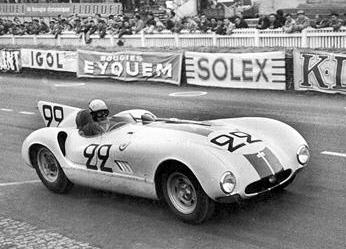The Le Mans Era
1955: Time And Chance
Text by Kane Rogers

Sherwood Johnston pilots the C-6R on Saturday afternoon;
the car has already lost its lower gears.
Foreshadowing his later relationship with Jaguar, Cunningham entered the 1955 Sebring 12 Hours with a factory-supported D-Type driven by Phil Walters and Mike Hawthorn, finishing first overall after a scoring debacle that had Carroll Shelby and Phil Hill briefly declared the winners.
Also entered was the new (and yet unpainted) C-6R, driven by Briggs and Benett. Lacking in development, the car retired on the fifty-fifth lap with transmission failure. The car would undergo several improvements before Le Mans, including a headrest/tailfin similar to that sported by the D-Type Jaguars, and a smaller grille opening to aid the car’s aerodynamics.
Yet its biggest weakness remained: the Meyer-Drake Offenhauser engine, which was well suited to its Indianapolis roots, could never be modified satisfactorily for the ever-changing loads applied by road racing. Converting it to run on gasoline reduced its power output to the extent that the car was slower than the previous year’s C-4R by almost eight miles per hour.
Yet it was the gearbox which bore the brunt of the Offy’s shortcomings, losing the lower gears early in the race. Driving to compensate for the lack of acceleration proved too much for the engine and the car was retired after eighteen hours with a burned piston.
The 1955 race was also the occasion of the worst accident in racing history. Pierre Levegh, driving a Mercedes 300SLR at over 150mph, swerved to avoid Lance Macklin’s Austin-Healey as the two passed a slowing Mike Hawthorn in front of the pits. The Mercedes glanced off the earthen bank across from the pits, deflected off the back of the Healey, and was launched into the crowd, breaking up as it went. Levegh was killed instantly; upwards of eighty spectators also perished. It was a shocking event, one which almost put an end to racing in Europe.
“I don’t believe that the accident had anything to do with my decision to stop building cars,” Briggs said years later, “but I don’t think that Phil Walters ever raced again. And I can’t say that I blame him.”
Website Disclaimer
Please read the disclaimer prior to entering this website. You may access it by clicking here.